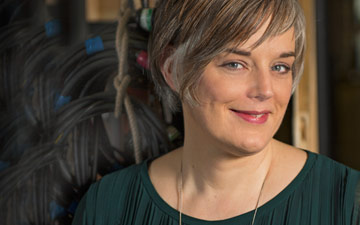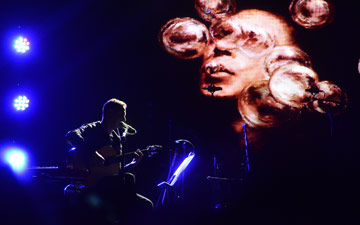
© Heathcliff O’Malley. (Click image for larger version)
No Body – Installations by Lucy Carter, Michael Hulls, Nitin Sawhney, Siobhan Davies and Russell Maliphant
★★★✰✰
London, Sadler’s Wells
7 June 2016
www.sadlerswells.com
It was Balanchine who said “Ballet is woman!”, to which Maurice Bejart responded “Dance is boys!” Whatever way you look at it, bodies dancing is what drives us, so what price a show without dancers – No Body indeed? It’s an intriguing idea to turn Sadler’s Wells, both front and back of house, into a multi-media performance space and hand it over to lighting designers Michael Hulls and Lucy Carter, musician/producer Nitin Sawhney and choreographers Siobhan Davies and Russell Maliphant. And the only bods around are the ushers and the audience.
To get people around all the installations you have to follow a prescribed route and the start was Lightspace, a 30 minute light show on the main Sadler’s Wells stage, where the audience is on the stage as well. It’s the work of Michael Hulls (and team) and at first you walk around some dangling clumps of tungsten bulbs, twinkling gently as they glow on and off in a random pattern. There is something very homely and analogue about old-style bulbs. In a digital and sharp-focused world they feel more natural – almost like flowers. An immersive softly beating score, jointly composed by Andy Cowton and Mukul, draws you in as the bulbs eventually ascend from view and we get a laser display projected down on us. Stand to the side and you can see the patterns it makes, getting ever more complex. A grid of lights ups the movement and we all feel under a microscope in a way. And there’s a wonderful coup de theatre as the lights fall on us and stop a couple of feet above our heads. Rather show-stopping. Exciting, but I still think the best of Lightspace was the tungsten lights at the start – magical.
After the Hulls, with its set length to be seen, you are then left to follow the marked route but in your own time. It starts with donning some headphones and as you walk up the foyer area stairs, getting ever higher, there are projectors showing dance through the ages at the Wells and you hear the interval audience rhubarbing away. Indelible was the work of Nitin Sawhney (and team) and nicely done, if there were no big ‘ooh’ moments. It culminated by bridging across into a small studio, back of house, which seemed to have many of us bamboozled with a sign inviting us to make a noise on a piano. It sounded like whatever one played may have gone on a tape loop, but it was all very faint and no fun, I thought. The programme says: “Here past, present and future meet in a simple binding revelation.” I don’t think it was working, or my ‘binding revelation’ neuron had gone walkabout.

© Gaby Agis. (Click image for larger version)
Siobhan Davies’ The Running Tongue video installation has a running woman (Helka Kaski) given movement devised by 22 dance artists with animations added. It’s all recorded digitally and the scenes are threaded together randomly on the fly – so you’d be unlikely to see it exactly the same twice. It feels a bit like Terry Gilliam’s work for Monty Python, but updated. Rather surreal and nothing stops the running Kaski from pressing on and on. A diverting way to spend 5 or 10 minutes, but no more, I think.
Lucy Carter (interview) got three smaller spaces for her three Hidden installations. The first was in Wigs and Wardrobe and I think this was inherently an interesting space full of the paraphernalia of costumes, fixing them up and washing them. The Control Room was her second space and again it was interesting as a working room – one was consciously seeing Lucy’s home, as it were. The final space was the Light Store in the bowels of the Wells and hard to get into and walk around because of very restricted headroom. And when the lights went out it became pitch black. We sat in a row opposite a long wall crammed with various lights, old and new, and received a dazzling light display that had our heads moving left and right, as if watching tennis, keen not to miss anything. I particularly liked the Mexican waves in light and it made me think about all the wiring and digital cleverness needed to programme it. For me the best 5 minutes of the night.

© Tristram Kenton. (Click image for larger version)
The No Body path finished by bringing us to Russell Maliphant’s video installation Kairos with a score by Mukul again. Three screens showed different views of 6 dancers, closely grouped and moving slowly in a chalky world. It was based on film originally shot for Erebus, a film adaptation of Maliphant’s The Rodin Project. To be honest it seemed a makeweight piece at odds with the thrust of what No Body was about – dancers are far better seen live then on video, no matter how well shot. But all up No Body was an interesting diversion, that confirms the artistic chops of the technical talent that makes so many shows pop and zing. As an exercise I hope it might be repeated every few years.

















You must be logged in to post a comment.